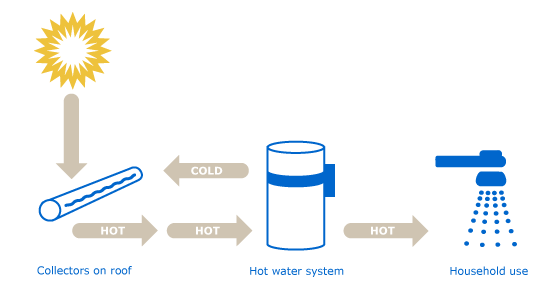
Defining a Solar Water Heating System –
Solar water heaters are considered as the right alternative for water heating in residential premises. If you’re looking to use a solar water heater in the Northern climates, it requires some sorts of protection against freezing. It can be done by means of a drain back where the water drains back into the house during the night to protect against freezing.
Otherwise, it can be done through an active closed loop with a heat exchanger that helps in transferring polypropylene heating fluid to the potable hot water. Hence, polypropylene can be chosen in the cold northern climates to handle the temperature below minus 40. As a result, the system won’t freeze and get damaged even if any malfunction occurs.
Different Components of a Solar Water Heater –
A solar water heater has four main components which are discussed below:
1. Solar Collector – It helps in capturing solar energy and converting it to heat energy.
2. Pump Station and Controller – Both of them helps in moving heat from the solar collector to the heat exchanger when positive heat energy gets transferred during the day time.
3. Heat Exchanger – It helps you transfer the usable heat energy from glycol to the potable water without combining both fluids.
4. Piping and Fittings – They help in connecting the system together and create a pressurized closed loop solar heating system.

Understanding Different Heat Exchangers –
However, a heat exchanger present in a solar water heater can be present inside a specifically designed storage tank or externally outside the storage tank. Both types work really well; but the internal heat exchanger offers zero heat loss.
In an internal heat exchanger, 100% heat energy is transferred to the potable water than an external heat exchanger which can lose a small amount of heat to the surrounding air.
Different Solar Water Heating Designs
Pre-Heat Solar Water Heating Design –
Generally, a pre-heat solar water heating system uses a two tank system. The primary tank is the existing hot water tank in the residential home. It can be gas, electric or on-demand. The secondary tank is present before the primary tank and is heated completely by solar energy.
The water from the secondary tank is drawn into the primary tank when the hot water tap opens. In this way, the solar system heats the water before coming into the primary tank. As a result, it requires less energy for heating hot water at home. 
Supplemental Water Heating Design –
A supplemental water heating design uses a single tank configuration. The top part of the tank comprises of an electric heating element. The solar energy heats the bottom part of the storage tank. When the hot water goes to the top, the back element may supply heat energy if there’s not enough solar energy; but the demand is high.
A supplemental solar water heater can utilize a standard electric water tank with disconnected power of the bottom element (electric heaters have both top and bottom heating element). The main benefit of a supplemental heating design is that it requires only a tank which is ideal for homes with limited space and new construction homes.
Bottom Line –
Are you looking to invest in solar water heaters? If yes, then you should look no further than Latitude51 Solar. We specialize in providing pre-heat and supplemental solar water heating designs best suiting the personal preferences and priorities of homeowners. For more information about our solar water heating packages, feel free to contact us today at +1(800) 317-9054.



